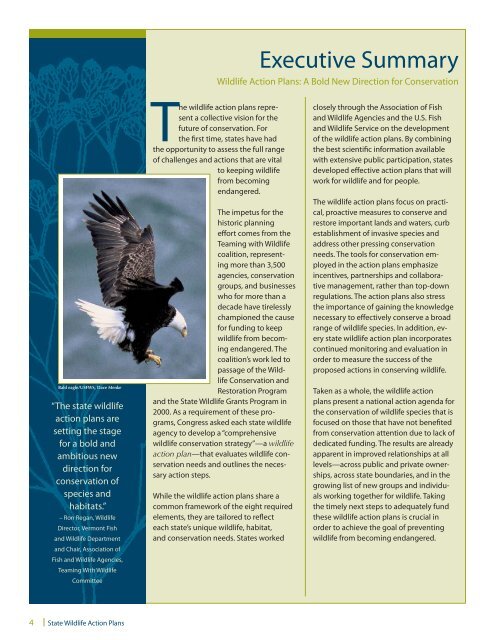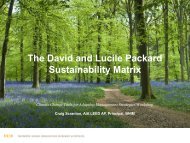State WAP Revised 8.29.06.indd - Teaming With Wildlife
State WAP Revised 8.29.06.indd - Teaming With Wildlife
State WAP Revised 8.29.06.indd - Teaming With Wildlife
Create successful ePaper yourself
Turn your PDF publications into a flip-book with our unique Google optimized e-Paper software.
Executive Summary<br />
<strong>Wildlife</strong> Action Plans: A Bold New Direction for Conservation<br />
Bald eagle/USFWS, Dave Menke<br />
“The state wildlife<br />
action plans are<br />
setting the stage<br />
for a bold and<br />
ambitious new<br />
direction for<br />
conservation of<br />
species and<br />
habitats.”<br />
– Ron Regan, <strong>Wildlife</strong><br />
Director, Vermont Fish<br />
and <strong>Wildlife</strong> Department<br />
and Chair, Association of<br />
Fish and <strong>Wildlife</strong> Agencies,<br />
<strong>Teaming</strong> <strong>With</strong> <strong>Wildlife</strong><br />
Committee<br />
The wildlife action plans represent<br />
a collective vision for the<br />
future of conservation. For<br />
the first time, states have had<br />
the opportunity to assess the full range<br />
of challenges and actions that are vital<br />
to keeping wildlife<br />
from becoming<br />
endangered.<br />
The impetus for the<br />
historic planning<br />
effort comes from the<br />
<strong>Teaming</strong> with <strong>Wildlife</strong><br />
coalition, representing<br />
more than 3,500<br />
agencies, conservation<br />
groups, and businesses<br />
who for more than a<br />
decade have tirelessly<br />
championed the cause<br />
for funding to keep<br />
wildlife from becoming<br />
endangered. The<br />
coalition’s work led to<br />
passage of the <strong>Wildlife</strong><br />
Conservation and<br />
Restoration Program<br />
and the <strong>State</strong> <strong>Wildlife</strong> Grants Program in<br />
2000. As a requirement of these programs,<br />
Congress asked each state wildlife<br />
agency to develop a “comprehensive<br />
wildlife conservation strategy”—a wildlife<br />
action plan—that evaluates wildlife conservation<br />
needs and outlines the necessary<br />
action steps.<br />
While the wildlife action plans share a<br />
common framework of the eight required<br />
elements, they are tailored to reflect<br />
each state’s unique wildlife, habitat,<br />
and conservation needs. <strong>State</strong>s worked<br />
closely through the Association of Fish<br />
and <strong>Wildlife</strong> Agencies and the U.S. Fish<br />
and <strong>Wildlife</strong> Service on the development<br />
of the wildlife action plans. By combining<br />
the best scientific information available<br />
with extensive public participation, states<br />
developed effective action plans that will<br />
work for wildlife and for people.<br />
The wildlife action plans focus on practical,<br />
proactive measures to conserve and<br />
restore important lands and waters, curb<br />
establishment of invasive species and<br />
address other pressing conservation<br />
needs. The tools for conservation employed<br />
in the action plans emphasize<br />
incentives, partnerships and collaborative<br />
management, rather than top-down<br />
regulations. The action plans also stress<br />
the importance of gaining the knowledge<br />
necessary to effectively conserve a broad<br />
range of wildlife species. In addition, every<br />
state wildlife action plan incorporates<br />
continued monitoring and evaluation in<br />
order to measure the success of the<br />
proposed actions in conserving wildlife.<br />
Taken as a whole, the wildlife action<br />
plans present a national action agenda for<br />
the conservation of wildlife species that is<br />
focused on those that have not benefited<br />
from conservation attention due to lack of<br />
dedicated funding. The results are already<br />
apparent in improved relationships at all<br />
levels—across public and private ownerships,<br />
across state boundaries, and in the<br />
growing list of new groups and individuals<br />
working together for wildlife. Taking<br />
the timely next steps to adequately fund<br />
these wildlife action plans is crucial in<br />
order to achieve the goal of preventing<br />
wildlife from becoming endangered.<br />
4<br />
<strong>State</strong> <strong>Wildlife</strong> Action Plans




